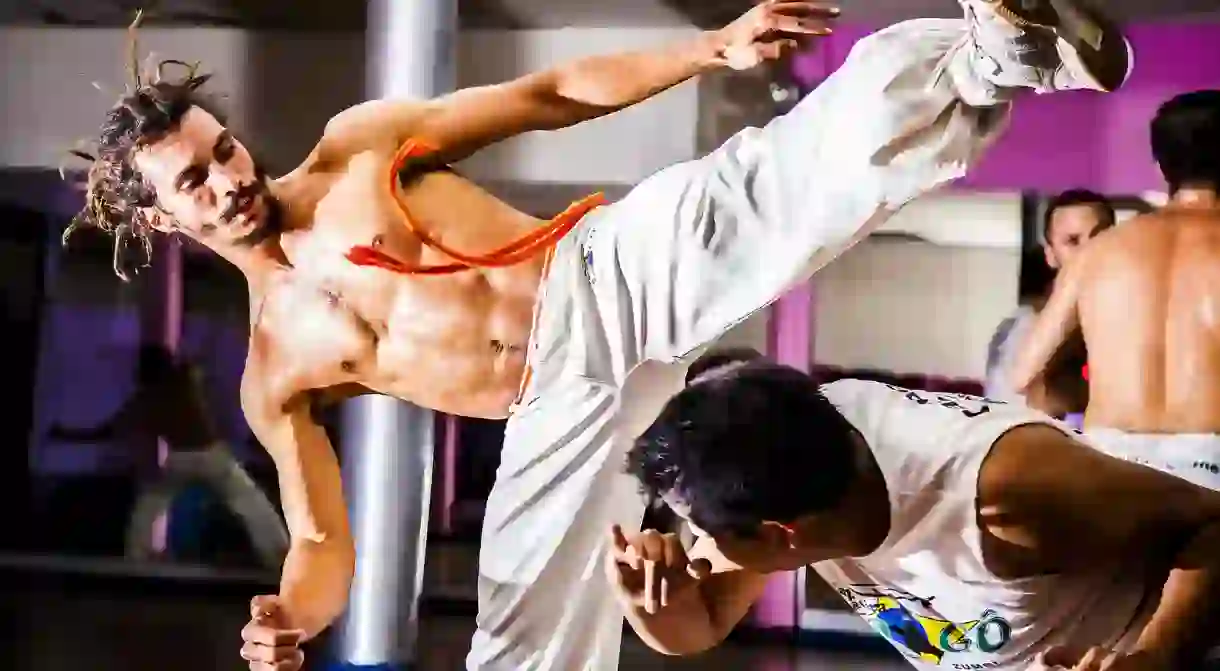A Brief Introduction to Capoeira

Part dance, part martial art, capoeira is integral to the culture of Brazil and has been slowly spreading in popularity worldwide. The music and movement of capoeira is a captivating experience, making it a must-see while in Brazil. Here is Culture Trip’s introduction to capoeira’s origins and history.
Like many traditions and customs in Brazil, and particularly northern Brazil, capoeira has roots in Africa because of the slave trade. Africans forced into slavery and brought to Brazil to labor on sugar and coffee plantations were limited in their ability to express their own customs and traditions, and they were strictly forbidden to do any kind of sparring or fighting practice.

The intermixing of African tribes on the slave plantations and in escaped slave colonies did lead to new traditions, and the rise of a different, Afro-Brazilian identity. Capoeira was born out of this next melding of African and Brazilian culture, as well as from a need to create a means of self defense without the actual appearance of fighting. The dancing and fluidity of movement in capoeira was designed to hide the fighting movements of a martial art. Instead of a sparring fight, capoeira looks like a dance of acrobatics, but hidden in the dance are a variety of martial arts moves, including punches and slaps, body throws and feints, kicks and headbutts. All the movements of martial art were disguised by the dance so slaves wouldn’t be discovered or reprimanded for training.

Capoeira is practiced in a circle formation, called the roda, within which two or more capoeiristas – those who practice capoeira – participate in the martial art. There are also specific instruments and music that accompany the practice of capoeira: the berimbau, the pandeiro and the atabaque. The berimbau is an instrument with a single string and has African origins. This instrument drives the speed of the capoeira practice – or game as some call it – within the circle. The pandeiro is a tambourine instrument that accompanies the main beat of the capoeira music that comes from the atabaque, or the drum. These simple but beautiful instruments, combined with the voices of the members of the roda, create a unique sound that recalls the African roots of capoeira.

Africans brought to Brazil in slavery often tried to rebel against their captivity, and capoeira was one of their most important developments. It began as a means of self defense, allowing slaves to practice fighting without looking like they were fighting. During the 1800s the abolitionist movement and the popularity of capoeira grew among blacks, and finally in 1888 the Lei Áurea was signed, ending slavery in Brazil. Though this was a pivotal moment for slaves, the blacks as well as indigenous people of Brazil were still often the target of discrimination, and they turned to capoeira for continued self defense. This was a difficult time in the country and people who practiced capoeira were often hired to take out the competition of rival political parties, creating a cycle of violence that eventually led capoeira to be banned.

Capoeira would remain a taboo until 1932, when Manuel dos Reis Machado – or Mestre Bimba, as he was known – persuaded the Brazilian authorities to allow for the opening of a capoeira school. Mestre Bimba was a pivotal figure in the resurgence of capoeira as a martial art form and not a means of criminal activity. He was also responsible for developing a new, more objective style of training.

Today capoeira is practiced around the world, and it is known for helping create increased body awareness as well as mental acuity. Capoeiristas benefit from faster reflexes and they learn how to create graceful, impactful movement through the martial art. They maintain healthy fitness habits, and it is an activity that can be – and is – practiced by people of all ages and gender. Consider trying a capoeira class at a local gym or training center, or anywhere in Brazil. It’s a unique way to connect to the history and culture of Brazil.













